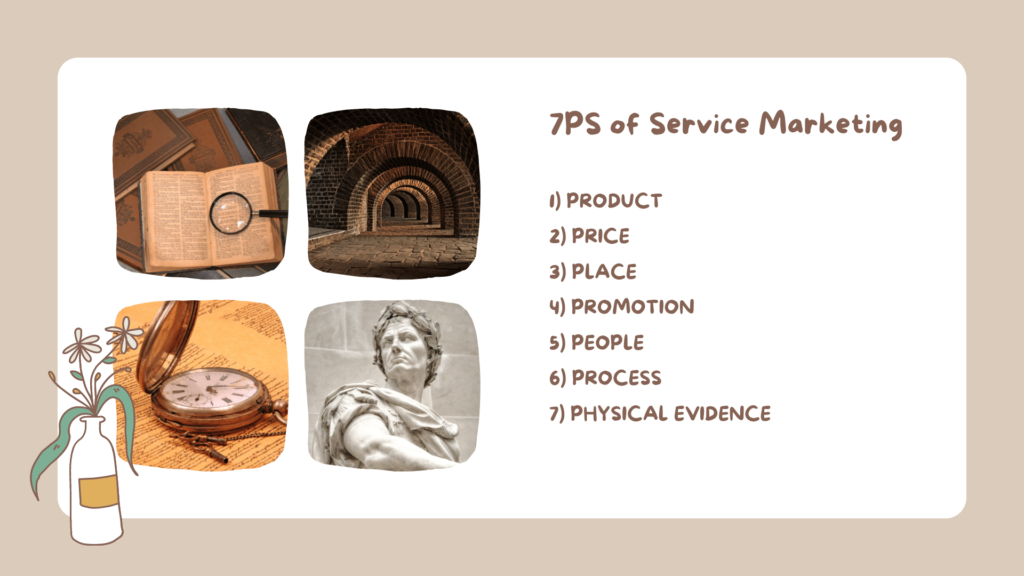What are the 7 PS of Service Marketing?
The 7ps of service marketing is a variation of the four ps of product marketing and focuses only on customer service industries like hotels, insurance companies, salons, aviation, etc. The 7ps of the service marketing mix are Product, Price, Place, Promotion, People, Process, and Physical evidence. These elements work together to create a marketing plan that is tailored to reach your target audience. 7ps of service marketing is a model that focuses on creating an emotional connection with your customers. This is done by providing them with high-quality, valuable customer experiences to achieve customer satisfaction. Additionally, this approach helps to build loyalty and encourage repeat business.

Product
The product is the actual thing you are selling to the customer. In a hotel, this could be a room with a bed or an airline ticket that can take you anywhere in the world. There are different types of products depending on the industry you are in and the target market. For example, a hotel might have different products depending on if it is a 3-star or 5-star hotel. The most effective products appeal to people’s emotions or senses in some way and can be easily sold through a variety of channels like online stores, television ads, or word-of-mouth advertising.
Price
The pricing strategy of your product will be the same for everyone but this could differ based on location and how many people are purchasing that product simultaneously. For example, if you are selling an airline ticket then the pricing will be different depending on where in the world it is purchased and how many people are purchasing that product at once. Price should reflect the value that your customers are getting for their money. Make sure that it is fair and well below competitors’ prices so that consumers have an incentive to buy from you instead of another brand. The price of the service package should be value-based for the end consumer.
Place
The place refers to the location of your business whether it is a hotel or an airport. This is where the product will be purchased and for this to happen there must be a certain level of trust between the business and the customer. For example, if you are selling an airline ticket, you want people to have a good impression of your company before purchasing from you so that when they arrive at the airport they will feel safe and comfortable. Channel refers to how buyers will access your product: through brick-and-mortar retail outlets or over the internet. The right place to market your product is essential to success. You need to ensure that your product is available at the right time, in the right quantity, and in the right place.
Promotion
Promotion is about marketing your product to potential customers so that they want to purchase from you and not anyone else. You can do this by having a website or an app on your phone where people can buy products, sending out flyers to potential customers, and advertising on television, social media like Facebook, and radio.
Promotion includes everything from advertisements on television networks and radio stations during prime time hours onward till after midnight as well as direct mail campaigns targeting specific demographics such as homeownership seekers pregnant women etc. Making it easier for your customers to reach you through the internet can play a crucial part in this ever-connected world for small businesses. If you are a big organization maintaining a public relations department can also do wonders in promoting your services in addition to your distribution channels.
People
The people refer to the employees of your business as well as any third-party companies that help you with things like transportation or packaging your product. For example, if you are a hotel then this could be an employee who is there at all times to take your customers to their rooms or it could be a third-party company that provides you with boxes and tape. In the case of services provided by different persons, you need to educate everyone involved so that the service quality doesn’t drop.
Process:
The quality of service provided varies from person to person. It is sort of personal selling. As a marketer, it is your job to ensure that the highest standard of service quality is provided irrespective of the person. As a service marketer, it is imperative for you to have tight control over the services marketing process as the service quality may vary from person to person. Good service delivery like a haircut is the end product of a good process maintained day in and day out for multiple customers.
Physical Evidence
Physical evidence refers to everything your customers see when interacting with your business. This includes:
- The physical environment where you provide the product or service
- The layout or interior design
- Your packaging – Packaging relates to how your product looks–from its design down to the use of recyclable materials if possible–and also any instructions needed by consumers before using it correctly such as dosage amounts or warnings about potential side effects.
- Your branding – Small things like the receipt you provide and the logo also contribute to your brand awareness and recall. Physical evidence can also refer to your staff and how they dress and act.
Why an understanding of the 7 P’s of services is important?
The first four ps of marketing play an important role for any business to succeed: Product is what you offer your customers or clients; Price speaks to the amount of money that you’re asking for this product; Placement deals with where you place this product on your Target Market’s buying journey, and Promotion relates to how often and how loudly you promote this product.
The next three Ps deal with customer acquisition/sales/engagement: Place-buying behavior refers to how likely a Target Market is going to buy or use your offering based upon their Psychographics – things like age group (teenagers vs. seniors), location (urban vs rural), interests, etc. Placements focus on where within these groups an individual is most likely to be found when looking for products such as yours; while placements talk about placing your offering in specific places – online banners or search engine results being two examples. Finally, there are the last two Ps which focus on profit & loss (profit) & customer retention/growth (customer).
In services marketing, knowing these elements play a crucial role to create a customer-centric marketing plan for you as a service provider. By understanding your customers (who you are serving), how you communicate with them (your process), what products and customer service you provide (products and services), and how much they should pay (prices) – you can design efficient marketing strategies that will achieve your business objectives.
